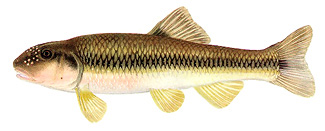Creek Chub
Semotilus atromaculatus
 Distribution: The range of the creek chub encompasses most of eastern North America, including the Great Lakes, Mississippi River, Gulf coast, Atlantic coast (excluding Florida and Georgia), and Hudson Bay drainages. Creek chub are common throughout New Hampshire in all except the coastal watersheds.
Distribution: The range of the creek chub encompasses most of eastern North America, including the Great Lakes, Mississippi River, Gulf coast, Atlantic coast (excluding Florida and Georgia), and Hudson Bay drainages. Creek chub are common throughout New Hampshire in all except the coastal watersheds.
Description: The creek chub looks similar to the fallfish with a more prominent lateral band and smaller scales. Creek chubs may be distinguished from other small minnow species by a dark spot at the base of the dorsal fin. Males grow horny tubercles on their head and snout during the spawning season.
Species commonly confused with: Fallfish, common shiner
Habitat: Creek chubs prefer small, moderate to high gradient, clear streams and rivers with gravel and sand substrate. They may occasionally be found in small ponds or lakes with gravel or sandy shorelines.
Life History: Creek chubs spawn in the spring as water temperatures approach 14°C. Male creek chubs excavate small nests in the sand or gravel above or below riffles. After spawning, pebbles are piled onto the nest to make a small mound. Creek chubs consume a varied diet of terrestrial and aquatic invertebrates and small fish. Like brook trout, they take advantage of shelter provided by deeper pools, undercut banks, and fallen trees in small streams. However, they are more tolerant of high water temperatures than brook trout and are therefore found in a wider variety of stream types across their range in New Hampshire.
Origin: Native
Conservation/Management: It is possible that the range of the creek chub will expand at the expense of brook trout with increases in stream temperature due to climate change. Displacement of cold water species, like brook trout and slimy sculpin, by creek chubs may also be a sign of habitat degradation along a stream or within its watershed. Vegetation removal in the riparian zone, increased runoff, water withdrawals, dam construction, or water level management can lead to increased water temperatures in streams. Monitoring the status and distribution of creek chub populations in different watersheds will be important for teasing out the impacts of climate change versus habitat degradation on aquatic communities.



